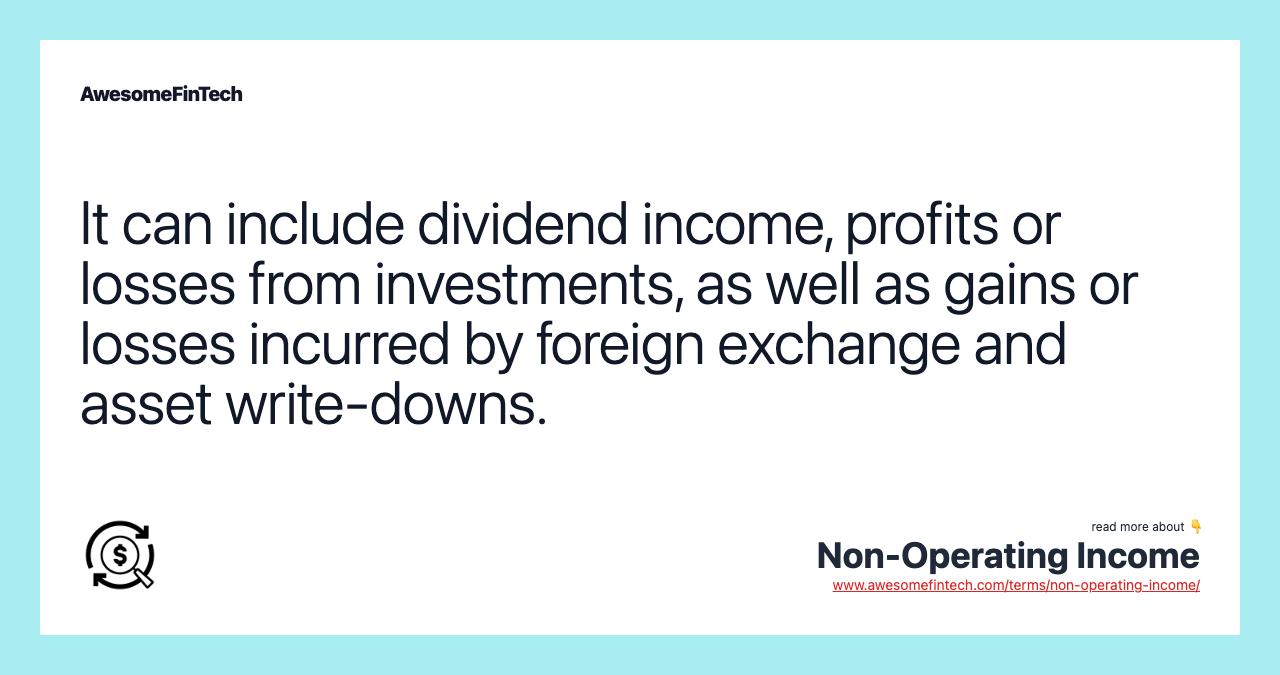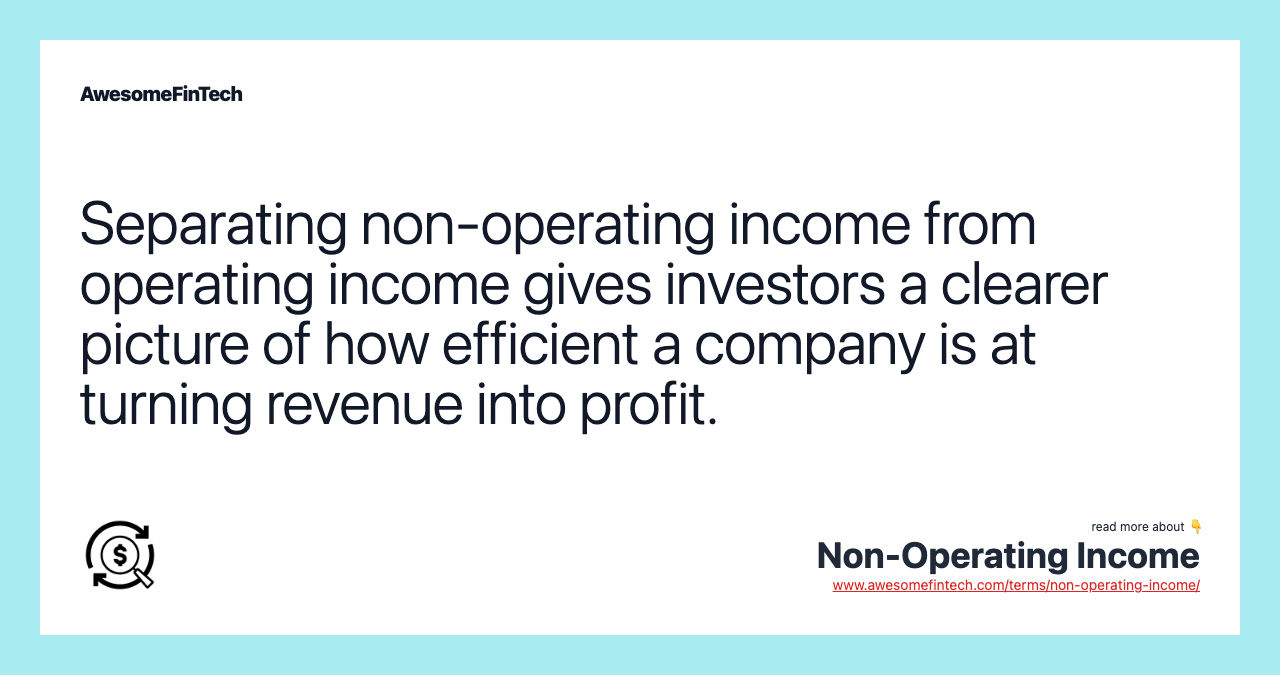Non-Operating Income
Non-operating income is the portion of an organization's income that is derived from activities not related to its core business operations. These types of gains — on top of income earned from recurring events outside of the business’ main line of work — can significantly alter a company’s earnings and make it difficult for investors to measure how well the firm’s operations actually fared during the reported period. Differentiating what income was generated from the day-to-day business operations and what income was made from other avenues is important to evaluate a company’s real performance. Toward the bottom of the income statement, under the operating income line, non-operating income should appear, helping investors to distinguish between the two and recognize what income came from where. Separating non-operating income from operating income gives investors a clearer picture of how efficient a company is at turning revenue into profit. Unfortunately, crafty accountants occasionally find ways to record non-operating transactions as operating income in order to dress up profitability in income statements.

What Is Non-Operating Income?
Non-operating income is the portion of an organization's income that is derived from activities not related to its core business operations. It can include items such as dividend income, profits, or losses from investments, as well as gains or losses incurred by foreign exchange and asset write-downs. Non-operating income is also referred to as incidental or peripheral income.



Understanding Non-Operating Income
Earnings are perhaps the single most studied number in a company's financial statements because they show profitability compared with analyst estimates and company guidance.
The problem is that profit in an accounting period can be skewed by things that have little to do with the everyday running of the business. For example, there are occasions when a company earns a significant, one-off amount of income from investment securities, a wholly owned subsidiary, or the sale of a large piece of equipment, property or land.
These types of gains — on top of income earned from recurring events outside of the business’ main line of work — can significantly alter a company’s earnings and make it difficult for investors to measure how well the firm’s operations actually fared during the reported period.
Non-Operating Income vs. Operating Income
Differentiating what income was generated from the day-to-day business operations and what income was made from other avenues is important to evaluate a company’s real performance. That is why firms are required to disclose non-operating income separately from operating income.
Operating income is an accounting figure that measures the amount of profit realized from a business's operations, after deducting operating expenses such as wages, depreciation, and cost of goods sold (COGS). In short, it provides information to interested parties about how much revenue was turned into profit through the company's normal and ongoing business activities.
Operating income is recorded on the income statement. Toward the bottom of the income statement, under the operating income line, non-operating income should appear, helping investors to distinguish between the two and recognize what income came from where.
Example of Non-Operating Income
The main operations of retail stores are the purchasing and selling of merchandise, which requires a lot of cash on hand and liquid assets**.** Sometimes, a retailer chooses to invest its idle cash on hand in order to put its money to work.
If a retail store invests $10,000 in the stock market, and in a one-month period earns 5% in capital gains, the $500 ($10,000 * 0.05) would be considered non-operating income. When a person sets out to analyze this retail company, the $500 would be discounted as earnings, because it can't be relied on as continuous income over the long term.
Alternatively, if a technology company sells or spins off one of its divisions for $400 million in cash and stock, the proceeds from the sale are considered non-operating income. If the technology company earns $1 billion in income in a year, it's easy to see that the additional $400 million will increase company earnings by 40%.
To an investor, a sharp bump in earnings like this makes the company look like a very attractive investment. However, since the sale cannot be replicated or duplicated, it can't be considered operating income and should be removed from performance analysis.
Special Considerations
Sometimes companies try to conceal poor operating profit with high, non-operating income. Beware of management teams attempting to flag metrics that incorporate inflated, separate gains. Earnings before interest and taxes (EBIT) for example, includes income derived from activities not related to the core business and can often be advertised heavily by companies to mask underwhelming operational results.
Often a sharp spike in earnings from one period to the next will be caused by non-operating income. Seek to get to the bottom of where money was generated and to ascertain how much of it, if any, is linked to the everyday running of the business and is likely to be repeated.
Operating income can help here, but not always. Unfortunately, crafty accountants occasionally find ways to record non-operating transactions as operating income in order to dress up profitability in income statements.
Related terms:
Accounting
Accounting is the process of recording, summarizing, analyzing, and reporting financial transactions of a business to oversight agencies, regulators, and the IRS. read more
Accounting Period
An accounting period is an established range of time during which accounting functions are performed and analyzed including a calendar or fiscal year. read more
Business Activities
Business activities are activities a business engages in for profit-making purposes, such as operations, investing, and financing activities. read more
Capital Gain
Capital gain refers to an increase in a capital asset's value and is considered to be realized when the asset is sold. read more
Cost of Goods Sold – COGS
Cost of goods sold (COGS) is defined as the direct costs attributable to the production of the goods sold in a company. read more
Depreciation
Depreciation is an accounting method of allocating the cost of a tangible asset over its useful life and is used to account for declines in value over time. read more
Discontinued Operations
In financial accounting, discontinued operations refer to parts of a company’s core business or product line that have been divested or shut down. read more
Dividend
A dividend is the distribution of some of a company's earnings to a class of its shareholders, as determined by the company's board of directors. read more
Earnings
A company's earnings are its after-tax net income, meaning its profits. Earnings are the main determinant of a public company's share price. read more
Financial Statements , Types, & Examples
Financial statements are written records that convey the business activities and the financial performance of a company. Financial statements include the balance sheet, income statement, and cash flow statement. read more